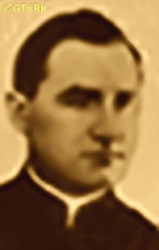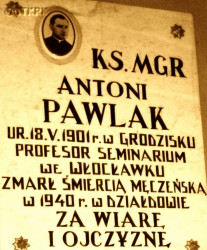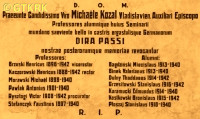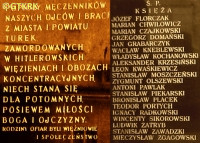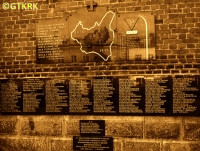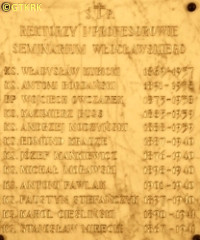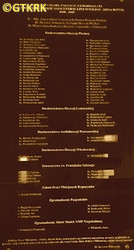Roman Catholic
St Sigismund parish
05-507 Słomczyn
85 Wiślana Str.
Konstancin deanery
Warsaw archdiocese, Poland
full list:
displayClick to display full list

searchClick to search full list by categories
wyświetlKliknij by wyświetlić pełną listę po polsku

szukajKliknij by przeszukać listę wg kategorii po polsku

Martyrology of the clergy — Poland
XX century (1914 – 1989)
personal data
surname
PAWLAK
forename(s)
Anthony (pl. Antoni)
function
diocesan priest
creed
Latin (Roman Catholic) Church RCmore on
en.wikipedia.org
[access: 2014.09.21]
diocese / province
Włocławek diocesemore on
en.wikipedia.org
[access: 2013.05.19]
academic distinctions
Philosopy MA
date and place
of death
1940

Komornicki foresttoday: Działdowo gm., Działdowo pov., Warmia‐Masuria voiv., Poland
more on
en.wikipedia.org
[access: 2022.01.28]
alt. dates and places
of death
KL Soldauconcentration camp
today: Działdowo, Działdowo urban gm., Działdowo pov., Warmia‐Masuria voiv., Poland
more on
en.wikipedia.org
[access: 2018.09.02]
AbL Groß‐Mischenslave labour camp
today: Miszewo‐Swobodnoje, Guryevsk reg., Królewiec oblast, Russia
AbL Rudauslave labour camp
today: Rudawa‐Melnikowo, Guryevsk reg., Królewiec oblast, Russia
details of death
After German and Russian invasion of Poland in 09.1939 and start of the World War II, after start of German occupation, arrested by the Germans on 15.10.1939 in Theological Seminary building in Włocławek, with Fr Michael Morawski and Fr Faustinus Stefańczyk.
Jailed in Włocławek prison.
Next held in Springborn camp (in Stoczek Warmiński Franciscan monastery).
From there prob. in 12.1939 transported to KL Hohenbruch concentration camp.
Finally on 17.03.1940 transported to KL Soldau concentration camp (then operated as DL Soldau, i.e. transit camp) where perished in unknown circumstances.
In the White Book it is assumed that was murdered in a nearby Komorniki forests in a mass execution during genocidal Germ. «Intelligenzaktion», extermination of Polish ruling classes and intelligentsia.
alt. details of death
According to some sources might have been held for some time in Stablack POW camp, and next in AbL Rudau and AbL Groß‐Mischen slave camps.
cause of death
extermination
perpetrators
Germans
sites and events
Komorniki forestsClick to display the description, KL SoldauClick to display the description, KL HohenbruchClick to display the description, SpringbornClick to display the description, AbL Groß‐MischenClick to display the description, AbL RudauClick to display the description, Stalag I A StablackClick to display the description, WłocławekClick to display the description, «Intelligenzaktion»Click to display the description, Ribbentrop‐MolotovClick to display the description, Pius XI's encyclicalsClick to display the description
date and place
of birth
18.08.1901Birth certification on:
photos.szukajwarchiwach.gov.pl
[access: 2025.08.19]

Grodziskotoday: Świnice Warckie gm., Łęczyca pov., Łódź voiv., Poland
more on
en.wikipedia.org
[access: 2022.01.28]
parents
PAWLAK Michael
🞲 ?, ? — 🕆 ?, ?

BRZĄKAŁA Antonina
🞲 ?, ? — 🕆 ?, ?
baptism
25.08.1901Birth certification on:
photos.szukajwarchiwach.gov.pl
[access: 2025.08.19]

Grodziskotoday: Świnice Warckie gm., Łęczyca pov., Łódź voiv., Poland
more on
en.wikipedia.org
[access: 2022.01.28]
St Peter and St Paul the Apostles RC church
presbyter (holy orders)
ordination
22.06.1930

positions held
1937 – 1939
lecturer — Włocławektoday: Włocławek city pov., Kuyavia‐Pomerania voiv., Poland
more on
en.wikipedia.org
[access: 2021.12.18] ⋄ Theological Seminary — dydactics professor; also: confessor, in 07‐08.1939 took a French language course in Grenoble in preparation for further specialist studies in France
1937 – 1939
prefect — Włocławektoday: Włocławek city pov., Kuyavia‐Pomerania voiv., Poland
more on
en.wikipedia.org
[access: 2021.12.18] ⋄ Pius X Gymnasium [i.e. Pius X Lyceum and Gymnasium (from 1937) / Lower Theological Seminary – Pius X Gymnasium (till 1937)] — also: educator and spiritual father
1933 – 1937
student — Krakówtoday: Kraków city pov., Lesser Poland voiv., Poland
more on
en.wikipedia.org
[access: 2021.06.07] ⋄ education, Department of Philosophy, Jagiellonian University UJ — postgraduate specialised studies crowned in 1938 with Philosophy Master's degree
1931 – 1933
prefect — Włocławektoday: Włocławek city pov., Kuyavia‐Pomerania voiv., Poland
more on
en.wikipedia.org
[access: 2021.12.18] ⋄ Pius X Gymnasium [i.e. Pius X Lyceum and Gymnasium (from 1937) / Lower Theological Seminary – Pius X Gymnasium (till 1937)] and Public Vocational Supplementary School
1931 – 1933
secretary — Włocławektoday: Włocławek city pov., Kuyavia‐Pomerania voiv., Poland
more on
en.wikipedia.org
[access: 2021.12.18] ⋄ Theological Seminary
1930 – 1931
vicar — Zduńska Wolatoday: Zduńska Wola urban gm., Zduńska Wola pov., Łódź voiv., Poland
more on
en.wikipedia.org
[access: 2021.12.18] ⋄ Assumption of the Blessed Virgin Mary RC parish ⋄ Sieradztoday: Sieradz urban gm., Sieradz pov., Łódź voiv., Poland
more on
en.wikipedia.org
[access: 2020.11.05] RC deanery — also: prefect of State Teachers' Seminary and elementary schools
1925 – 1930
student — Włocławektoday: Włocławek city pov., Kuyavia‐Pomerania voiv., Poland
more on
en.wikipedia.org
[access: 2021.12.18] ⋄ philosophy and theology, Theological Seminary
others related
in death
BIAŁYClick to display biography Vladislav, BRZUSKIClick to display biography Henry, CIBOROWSKIClick to display biography Thaddeus, KACZOROWSKIClick to display biography Henry Sigismund, KRYSIAKClick to display biography Andrew, KURACHClick to display biography Anthony, LATARSKIClick to display biography Joseph, MORAWSKIClick to display biography Michael, ROGIŃSKIClick to display biography Joseph Stanislav, RYSZTOGIClick to display biography Victor, STEFAŃCZYKClick to display biography Faustinus, WĄDOŁOWSKIClick to display biography Francis, BAGDZIŃSKIClick to display biography Mieczyslav, CHWIŁOWICZClick to display biography Mieczyslav, JANKOWSKIClick to display biography Anthony, KEMPIŃSKIClick to display biography Stanislav, KLEPACZEWSKIClick to display biography Louis, KŁAPKOWSKIClick to display biography Vladislav, KRYSIŃSKIClick to display biography John Julian, ŁADAClick to display biography Alex, MIASTKOWSKIClick to display biography Anthony, PIEŃKOWSKIClick to display biography Vladislav, PŁOSZAJClick to display biography Stanislav, RAMOTOWSKIClick to display biography Vladislav, ROSZKOWSKIClick to display biography Ceslav, SZCZEPANOWSKIClick to display biography Stanislav Felix, SZCZODROWSKIClick to display biography Marian, SZYMCZYKClick to display biography Joseph
sites and events
descriptions
Komorniki forests: Series of mass murders perpetrated by Germans at the bottom of Komorniki Hill, c. 6 km from Działdowo. Victims were Poles, representatives of Germ. Führungsschicht (Eng. Leading Classes), teachers, Catholic priests, office workers, farmers, political and social activists — prisoners of then DL Soldau Germ. „Durchgangslager für polnische Zivilgefangene” (Eng. „transit camp for Polish civilian POWs”). The first of the murders was prob. in 12.1939, on 34 teachers in Ciechanów county. Later prisoners transported from KL Hohenbruch, AbL Rudau, AbL AbL Groß‐Mischen, AbL Baydritten, Stalag I B Hohenstein camps in East Prussia, arrested earlier, were murdered. The victims were brought to the execution site — the trenches of 8 m × 6 m × 2 m were dug out earlier — in trucks and murdered from machine guns fire. Some individuals were executed in DL Soldau camp itself — in the basements of one of camp’s buildings. There they were killed with single shots to the head and bodies were subsequently buried in Komorniki forests. Altogether c. 1,500 people were murdered then, including c. 26. Catholic priests. (more on: pl.wikipedia.orgClick to attempt to display webpage
[access: 2020.07.31])
KL Soldau: German Germ. Konzentrationslager (Eng. concentration camp) KL Soldau (in modern Działdowo city) — since the pre‐war Polish Działdowo county was incorporated into Germ. Regierungsbezirk Allenstein (Eng. Olsztyn regency) the camp was located in occupied territories where general German law was in force, i.e. in Germany proper — was founded in 09.1939, when in former barracks of 32nd Infantry Regiment of Polish Army Germans set up a temporary camp for POW captured during September 1939 campaign. In autumn 1939 was also used as police jail. In 1939‐1940 changed into Germ. Durchgangslager für polnische Zivilgefangene (Eng. Transit Camp for Polish Civilians), prior to transport to other concentration camps. In reality it was used then as a place of extermination of Polish intelligentsia within Germ. «Intelligenzaktion» genocidal program and extermination of sick and disabled within «Aktion T4» program. Next in 05.1940 the camp was changed again into Germ. Arbeitserziehungslager (Eng. Work Education Camp), and finally into penal comp for criminal and political prisoners, most of whom were sentenced to death. In 1939‐1941 Germans imprisoned, maltreated and tortured in KL Soldau hundreds of Polish priests and religious. Approx. 80 priests, religious and nuns perished. They were murdered in the camp itself, by a shot into a head, or in places of mass executions in nearby forests — Białuty forest, Malinowo forets, Komorniki. Dates and precise locations of these murders remain unknown. Altogether in KL Soldau approx. 15,000 prisoners were murdered, including thousands victims — patients of psychiatric institutions (within «Aktion T4» plan). (more on: mazowsze.hist.plClick to attempt to display webpage
[access: 2013.08.17], en.wikipedia.orgClick to attempt to display webpage
[access: 2018.09.02])
KL Hohenbruch: German Germ. Konzentrationslager (Eng. concentration camp) KL Hohenbruch and forced labour camp, mainly for Poles — e.g. captured during «Intelligenzaktion» — in operation in 1939‐1944/1945 in East Prussia, n. Konigsberg. Prisoners — a few thousands — slaved mainly at forest clearances and swamp draining. C. 200 perished murdered. (more on: pl.wikipedia.orgClick to attempt to display webpage
[access: 2013.08.17])
Springborn: In Franciscan monastery in Springborn (now: Stoczek Klasztorny) Germans interned and jailed many priests starting from 1938. In 1938 Austrian bishops were held captive there. In 1939, after German invasion of Poland, Polish priests from northern Poland were being held there prior to being sent to concentration camps. After 1945 commi‐nazi authorities held Polish Primate, cardinal Stephen Wyszyński in the monastery. (more on: pl.wikipedia.orgClick to attempt to display webpage
[access: 2015.05.09])
AbL Groß‐Mischen: AbL Groß‐Mischen (Miszewo‐Svobodnoye in Sambia) was a German camp where approx. 200 teachers of secondary schools and priest from Włocławek and vicinity were held among others in 1939 — as part of Germ. «Intelligenzaktion», German program of physical extermination of Polish intelligentsia and leading classes — and were forced to work on e.g. motorway constructions. The camp operated prob. as Germ. Arbeitslager (Eng. Labour Camp) — and thus it is assumed in White Book. It was dissolved in c. 12.1939 / 01.1940 and the letters sent to inmates were returned with a note „addressee unknown”. None of the prisoners held in Rudau, AbL Groß‐Mischen and AbL Beidritten camps ever returned home — all Polish prisoners at the beginning of 1940 were transferred to KL Soldau (then DL Soldau) and prompty murdered during Germ. «Intelligenzaktion» against Polish leading classes. (more on: pamiec.plClick to attempt to display webpage
[access: 2014.03.10])
AbL Rudau: AbL Rudau II bei Königsberg (now Melnikovo) was a German camp where approx. 200 teachers of secondary schools and priest from Włocławek and vicinity were held among others in 1939 — as part of Germ. «Intelligenzaktion», German program of physical extermination of Polish intelligentsia and leading classes — and were forced to work on e.g. motorway constructions. The camp operated prob. as Germ. Arbeitslager (Eng. Labour Camp) — and thus it is assumed in White Book. It was dissolved in c. 12.1939 / 01.1940 and the letters sent to inmates were returned with a note „ addressee unknown”. None of the prisoners held in Rudau, AbL Groß‐Mischen and AbL Beidritten camps ever returned home — all Polish prisoners at the beginning of 1940 were transferred to KL Soldau (then DL Soldau) and prompty murdered during Germ. «Intelligenzaktion». (more on: www.1wrzesnia39.plClick to attempt to display webpage
[access: 2013.10.05])
Stalag I A Stablack: Stalag I A — German POW camp for non‐commissioned officers and privates in the vicinity of todays Stabławek and Kamińsk villages (Bartoszyce county) and partly n. Dołgorukowo, then in Preussich Eylau county (today in Russian Królewiec enclave). After attack of Poland Germans brought to it till the end of 09.1939 c. 40,000 POWs. Altogether during 1939‐1945 c. 255,000 prisoners from whole Europe were held there. More than 10 thousand perished. (more on: pl.wikipedia.orgClick to attempt to display webpage
[access: 2014.03.10], en.wikipedia.orgClick to attempt to display webpage
[access: 2014.03.10])
Włocławek: Police detention centre at Karnkowski Str. in downtown Włocławek run by Germans. In 1939‐1940 Germans held there hundreds of Poles, including dozens of Polish priests, that were subsequently transported to German concentration camps. (more on: www.sztetl.org.plClick to attempt to display webpage
[access: 2017.01.21])
«Intelligenzaktion»: German: «Intelligenzaktion» (English: „Intelligence Action”) — a German program of extermination of the Polish elite, mainly the intelligentsia and leadership layers, carried out from the beginning of the occupation in w 09.1939 to 04.1940, mainly in territories directly annexed to Germany, but also in the so‐called Germ. Generalgouvernement (Eng. General Governorate), where it was called «AB‐aktion». In the first phase, immediately after the beginning of the German occupation, during military operations carried out by the Germ. Wehrmacht (Eng. Armed Forces) and the genocidal units of the Germ. Einsatzgruppen (Eng. Operational Groups) of the Germ. Sicherheitspolizei (Eng. Security Police), i.e. SiPo, and Germ. Sicherheitsdienst des Reichsführers SS (Eng. Security Service of the Reichsführer SS), i.e. SD, organized by the Germ. Reichssicherheitshauptamt (Eng. Reich Main Security Office), i.e. RSHA, which followed the troops, carried out under the Germ. Unternehmen „Tannenberg” (Eng. Operation „Tannenberg”) — based on the so‐called Germ. Sonderfahndungsliste (Eng. Special Wanted Lists), i.e. proscription lists of Poles considered particularly dangerous to the Third Reich, prepared by the Zentralstelle II/P (Polen) unit of the German RSHA. Later, implemented by the German civilian occupation authorities and the genocidal unit of the Germ. Volksdeutscher Selbstschutz (Eng. Ethnic Germans Self‐Defense), whose members were Germ. Volksdeutsche (Eng. Ethnic Germans), i.e. representatives of the German minority in Poland. According to various sources, these lists, at the beginning of 09.1939, could have contained the details of 61,000—88,000 „dangerous” Poles — although these figures cannot be confirmed. In total, during this genocide, c. 50,000 teachers, Catholic priests, representatives of the landed gentry, freelancers, social and political activists, and retired military personnel were systematically and methodically murdered. Another 50,000 were sent to concentration camps, where only a negligible percentage survived. (more on: en.wikipedia.orgClick to attempt to display webpage
[access: 2014.10.04])
Ribbentrop‐Molotov: Genocidal Russian‐German alliance pact between Russian leader Joseph Stalin and German leader Adolf Hitler signed on 23.08.1939 in Moscow by respective foreign ministers, Mr. Vyacheslav Molotov for Russia and Joachim von Ribbentrop for Germany. The pact sanctioned and was the direct cause of joint Russian and German invasion of Poland and the outbreak of the World War II in 09.1939. In a political sense, the pact was an attempt to restore the status quo ante before 1914, with one exception, namely the „commercial” exchange of the so‐called „Kingdom of Poland”, which in 1914 was part of the Russian Empire, fore Eastern Galicia (today's western Ukraine), in 1914 belonging to the Austro‐Hungarian Empire. Galicia, including Lviv, was to be taken over by the Russians, the „Kingdom of Poland” — under the name of the General Governorate — Germany. The resultant „war was one of the greatest calamities and dramas of humanity in history, for two atheistic and anti‐Christian ideologies — national and international socialism — rejected God and His fifth Decalogue commandment: Thou shall not kill!” (Abp Stanislav Gądecki, 01.09.2019). The decisions taken — backed up by the betrayal of the formal allies of Poland, France and Germany, which on 12.09.1939, at a joint conference in Abbeville, decided not to provide aid to attacked Poland and not to take military action against Germany (a clear breach of treaty obligations with Poland) — were on 28.09.1939 slightly altered and made more precise when a treaty on „German‐Russian boundaries and friendship” was agreed by the same murderous signatories. One of its findings was establishment of spheres of influence in Central and Eastern Europe and in consequence IV partition of Poland. In one of its secret annexes agreed, that: „the Signatories will not tolerate on its respective territories any Polish propaganda that affects the territory of the other Side. On their respective territories they will suppress all such propaganda and inform each other of the measures taken to accomplish it”. The agreements resulted in a series of meeting between two genocidal organization representing both sides — German Gestapo and Russian NKVD when coordination of efforts to exterminate Polish intelligentsia and Polish leading classes (in Germany called «Intelligenzaktion», in Russia took the form of Katyń massacres) where discussed. Resulted in deaths of hundreds of thousands of Polish intelligentsia, including thousands of priests presented here, and tens of millions of ordinary people,. The results of this Russian‐German pact lasted till 1989 and are still in evidence even today. (more on: en.wikipedia.orgClick to attempt to display webpage
[access: 2015.09.30])
Pius XI's encyclicals: Facing the creation of two totalitarian systems in Europe, which seemed to compete with each other, though there were more similarities than contradictions between them, Pope Pius XI issued in 03.1937 (within 5 days) two encyclicals. In the „Mit brennender Sorge” (Eng. „With Burning Concern”) published on 14.03.1938, condemned the national socialism prevailing in Germany. The Pope wrote: „Whoever, following the old Germanic‐pre‐Christian beliefs, puts various impersonal fate in the place of a personal God, denies the wisdom of God and Providence […], whoever exalts earthly values: race or nation, or state, or state system, representatives of state power or other fundamental values of human society, […] and makes them the highest standard of all values, including religious ones, and idolizes them, this one […] is far from true faith in God and from a worldview corresponding to such faith”. On 19.03.1937, published „Divini Redemptoris” (Eng. „Divine Redeemer”), in which criticized Russian communism, dialectical materialism and the class struggle theory. The Pope wrote: „Communism deprives man of freedom, and therefore the spiritual basis of all life norms. It deprives the human person of all his dignity and any moral support with which he could resist the onslaught of blind passions […] This is the new gospel that Bolshevik and godless communism preaches as a message of salvation and redemption of humanity”… Pius XI demanded that the established human law be subjected to the natural law of God , recommended the implementation of the ideal of a Christian state and society, and called on Catholics to resist. Two years later, National Socialist Germany and Communist Russia came together and started World War II. (more on: www.vatican.vaClick to attempt to display webpage
[access: 2023.05.28], www.vatican.vaClick to attempt to display webpage
[access: 2023.05.28])
sources
personal:
mazowsze.hist.plClick to attempt to display webpage
[access: 2012.11.23], martyrologia.wloclawek.plClick to attempt to display webpage
[access: 2013.10.05], photos.szukajwarchiwach.gov.plClick to attempt to display webpage
[access: 2025.08.19], lodz-andrzejow.plClick to attempt to display webpage
[access: 2024.06.09]
bibliographical:
„Victims of German crime among Włocławek diocese clergy”, Fr Stanislav Librowski, „Włocławek Diocese Chronicle”, 07‐08.1947
„Annals of the Włocławek diocese — 1926‐1939 (also: Catalogus Ecclesiarum et Utriusque Cleri tam Saecularis quam Regularis dioecesis Wladislaviensis seu Calissiensis — till 1925)”, Włocławek and Włocławel-Kalisz diocesan Curia
original images:
panaszonik.blogspot.comClick to attempt to display webpage
[access: 2016.03.14], panaszonik.blogspot.comClick to attempt to display webpage
[access: 2016.03.14], pomniki.wloclawek.plClick to attempt to display webpage
[access: 2018.11.18], pomniki.wloclawek.plClick to attempt to display webpage
[access: 2020.09.26], radioolsztyn.plClick to attempt to display webpage
[access: 2021.08.06]
LETTER to CUSTODIAN/ADMINISTRATOR
If you have an Email client on your communicator/computer — such as Mozilla Thunderbird, Windows Mail or Microsoft Outlook, described at WikipediaPatrz:
en.wikipedia.org, among others — try the link below, please:
LETTER to CUSTODIAN/ADMINISTRATORClick and try to call your own Email client
If however you do not run such a client or the above link is not active please send an email to the Custodian/Administrator using your account — in your customary email/correspondence engine — at the following address:

giving the following as the subject:
MARTYROLOGY: PAWLAK Anthony
To return to the biography press below:
 Click to return to biography
Click to return to biography








